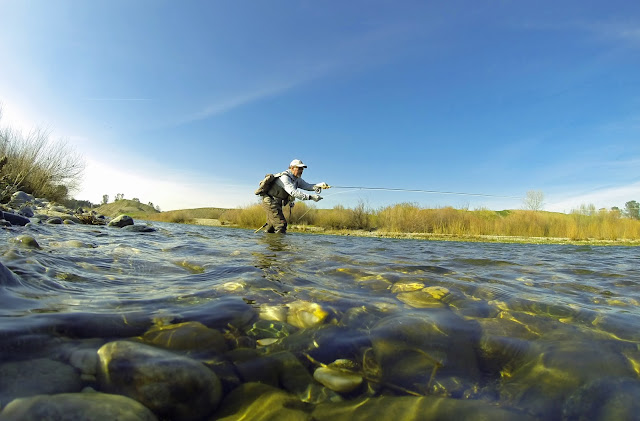
Finally our false spring is coming to an end today with a
forecast of up to 3 inches of precipitation for the foothills. We’ll have to
watch the Englebright and Deer Creek gauges closely to see what transpires in
the next few days. Regardless of how much of a flow is coming down the river
and being blown out, the clarity is still not good; Englebright Reservoir keeps
pumping out fresh brewed coffee in various degrees of visibility from 1.5 to 3
feet. I’m finding the water is a little cleaner in the lower Yuba River below
Dry Creek (which is running clear). Flows at this time are 1,093 cubes out of
Englebright dam, and 33 cfs from Deer Creek. Since the river has changed in
spots from the high flows, be cautious crossing areas that you are familiar
with, you can’t see very well through the dirty water, so probe with your staff
before you take a step. The latest aquatic insect sampling continues to show
small baetis nymphs, ryacafilia free living caddis, worms, and a few March
Brown clinger mayflies in the riffles. No big stoneflies, or other larger bugs
have been recorded since the 16k pulse release, it’s all small ball. I have
found at least a half dozen dead sculpins 2 to 3” long in the shallow back
eddies, most likely victims of the movement of gravel and cobble from the last
surge.

The skwalas have also been on the light side since the big
flows, but they are out there. I really have to spend a lot of time investigating
the side water, willows, and dry cobble to be able to find them. I did well
last week in a 2 hour window fishing the dry with 6 fish, and just happen to be
at the right place at the right time (think 1 to 4pm). Even with dirty water, a
dark colored skwala adult floating against a bright sky does stick out and
creates quite the silhouette for a trout looking up. Another fact is not all
skwala rises are explosive. If you have ever just sat on the bank and observed
a productive run, you’ll see rises of trout that are just a nose popping out
briefly while slurping down a skwala adult. The bigger fish can suck down an
adult in the soft side water without even breaking the surface, something I
observed and learned on the Madison River fishing hoppers a long time ago. Keep
in mind the adult skwala stoner can drink water and eat as well, and they live
about a month as long as a bird or a trout does not eat them. There are still
other quality hatches coming up in the near future for those of us that like
fishing dry flies no matter how many or little we hook.

Nymphing is going to get it done right now, and swinging
some meat and potatoes flies are another fruitful prospect. I have a little
over a dozen trips coming up until March 6th so I will be even more
in tune with the river. There are 13 days that I have open in March at this
time if you’re interested in learning the river, techniques, tactics, and a
thorough understanding of the entomology, and the hatches. Shoot me an email at
baiocchistroutfitters@yahoo.com
to get the ball rolling.
Truckee River Report/Vacation
I spent another couple of days wading in the Truckee River
free fishing on my own the past few days which does not happen very often of
late, and I’m so appreciative of being able to. The weather was too nice, so
good that just sitting on the bank listening to the river was good enough for
me. I did not do as well as last week mostly because I did not put in that many
casts, and instead relished the good company I was with. Water temps ranged
from 45 to 48 degrees, the trout seem to be spread out, but some areas of the
river with slow deep water with a little current and foam lines are holding big
numbers of fish. There were tons of midges out, no clusters on the surface that
I saw, and no heads showing as well. Bummer.

Nymphing is the most productive way to get into them right
now whether you’re high sticking, using a bobber, or swinging soft hackles.
When in doubt, add more weight and lengthen the distance from your bobber to
your weight placement. That small adjustment can make a world of difference on
the Truckee River. Top flies right now are dark baetis patterns in olive,
brown, and black, red and flesh Juan worms, and tiny Zebra Midges. 18 to 24” of
snow is forecasted for the upper elevations with this current storm, and the region
will be back into winter for a few days. Word from the Italian forecaster on
Donner Summit is the long range model will change with a wetter pattern near
March 1st after a period of dry weather. Typically March and April
are strong months during an El Nino event, but just what is typical weather in
our modern world these days? See ya on the water…



































